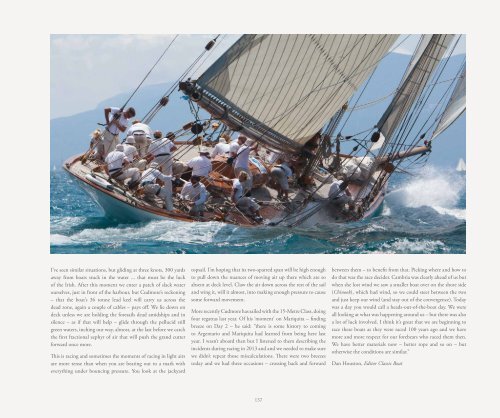Mariquita Book - mk2.5
- No tags were found...
Create successful ePaper yourself
Turn your PDF publications into a flip-book with our unique Google optimized e-Paper software.
I’ve seen similar situations, but gliding at three knots, 300 yards<br />
away from boats stuck in the water ... that must be the luck<br />
of the Irish. After this moment we enter a patch of slack water<br />
ourselves, just in front of the harbour, but Cudmore’s reckoning<br />
– that the boat’s 36 tonne lead keel will carry us across the<br />
dead zone, again a couple of cables – pays off. We lie down on<br />
deck unless we are holding the foresails dead amidships and in<br />
silence – as if that will help – glide through the pellucid still<br />
green waters, inching our way, almost, at the last before we catch<br />
the first fractional zephyr of air that will push the grand cutter<br />
forward once more.<br />
This is racing and sometimes the moments of racing in light airs<br />
are more tense than when you are beating out to a mark with<br />
everything under bouncing pressure. You look at the jackyard<br />
topsail. I’m hoping that its two-sparred span will be high enough<br />
to pull down the nuances of moving air up there which are so<br />
absent at deck level. Claw the air down across the rest of the sail<br />
and wing it, will it almost, into making enough pressure to cause<br />
some forward movement.<br />
More recently Cudmore has sailed with the 15-Metre Class, doing<br />
four regattas last year. Of his ‘moment’ on <strong>Mariquita</strong> – finding<br />
breeze on Day 2 – he said: “there is some history to coming<br />
to Argentario and <strong>Mariquita</strong> had learned from being here last<br />
year. I wasn’t aboard then but I listened to them describing the<br />
incidents during racing in 2013 and and we needed to make sure<br />
we didn’t repeat those miscalculations. There were two breezes<br />
today and we had three occasions – crossing back and forward<br />
between them – to benefit from that. Picking where and how to<br />
do that was the race decider. Cambria was clearly ahead of us but<br />
when she lost wind we saw a smaller boat over on the shore side<br />
(Chinook), which had wind, so we could steer between the two<br />
and just keep our wind (and stay out of the convergence). Today<br />
was a day you would call a heads-out-of-the-boat day. We were<br />
all looking at what was happening around us – but there was also<br />
a lot of luck involved. I think it’s great that we are beginning to<br />
race these boats as they were raced 100 years ago and we have<br />
more and more respect for our forebears who raced them then.<br />
We have better materials now – better rope and so on – but<br />
otherwise the conditions are similar.”<br />
Dan Houston, Editor Classic Boat<br />
137







